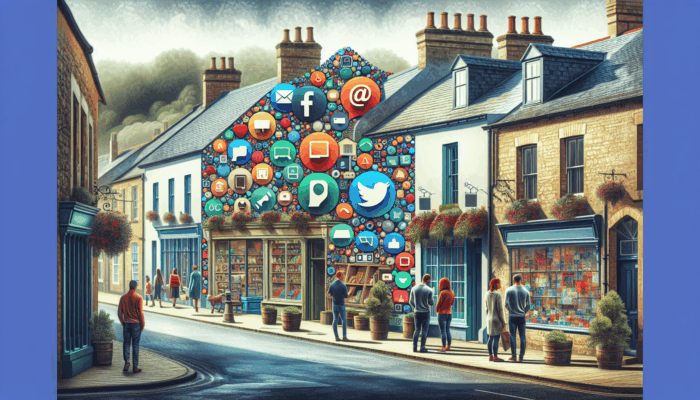Table of Contents
ToggleTailored Services Designed to Meet Your Unique Business Requirements
Enhancing Your Online Presence with Professional Search Engine Optimisation (SEO)

To establish a powerful online presence, it is vital to engage effective digital marketing agency services, particularly focusing on Search Engine Optimisation (SEO). SEO combines both the art and science of elevating your website’s visibility and ranking on major search engines like Google, Bing, and Yahoo. By strategically employing keyword optimisation, refining on-page elements, and building high-quality backlinks, a dedicated SEO strategy can profoundly increase organic traffic to your site, enhancing brand visibility and fostering customer engagement.
Take, for example, a local bakery striving to draw in more customers. By fine-tuning their website with relevant keywords such as “artisan bread” and “fresh pastries,” they can secure higher rankings in search results, resulting in increased foot traffic and online orders. Importantly, SEO is an ongoing process; it requires continuous updates and adjustments in response to shifting industry trends and algorithm changes. A comprehensive SEO strategy lays the groundwork for sustainable growth, empowering businesses to maintain their competitive edge in a saturated marketplace.
Furthermore, the importance of local SEO is paramount. For businesses focused on specific geographic areas, optimising for local search terms and ensuring a complete Google My Business profile can lead to substantial advantages. When potential customers search for products or services nearby, an optimally structured local presence ensures visibility, ultimately enhancing conversion rates and driving customer acquisition.
In a digital age where consumers increasingly rely on online searches to inform their purchasing choices, implementing a robust SEO strategy can be the determining factor that separates obscurity from visibility. Investing in SEO not only amplifies traffic volumes but also reinforces your brand’s credibility and trustworthiness in the consumer landscape.
Generating Instant Traffic with Pay-Per-Click Advertising (PPC)
In the dynamic realm of online marketing, Pay-Per-Click (PPC) advertising has emerged as a formidable pathway for businesses seeking to generate immediate traffic and optimise return on investment. This advertising model allows businesses to display their ads on search engines and social media platforms, incurring costs solely when users click on their advertisements.
For instance, a software company launching a new application can design targeted PPC campaigns on platforms like Google or Facebook, effectively reaching potential users. By selecting specific keywords and demographic parameters, the company can ensure its advertisements are shown to audiences most likely to convert. The immediate results offered by PPC are particularly enticing; in contrast to SEO, which can take time to show effects, PPC can drive traffic almost instantly, making it ideal for promoting time-sensitive offers or launching new products.
Moreover, PPC advertising provides extensive analytics capabilities, empowering marketers to monitor performance in real-time. This data-driven approach enables advertisers to continuously refine their strategies, making necessary adjustments based on performance metrics. Conducting A/B testing on different ad copies, landing pages, and bidding strategies can significantly enhance campaign optimisation, ultimately leading to lower acquisition costs.
In an increasingly competitive global marketplace, PPC advertising stands out as a cost-effective strategy for generating leads and driving sales. When executed with precision, it not only delivers immediate outcomes but also complements other marketing efforts by enhancing brand recognition and awareness.
Broadening Your Reach Through Strategic Social Media Marketing
The rise of social media platforms has revolutionised how businesses connect with their audiences, establishing social media marketing as an essential component of a comprehensive digital marketing strategy. By leveraging platforms such as Facebook, Instagram, Twitter, and LinkedIn, brands can engage with their target audiences on a more personal level, fostering brand loyalty and strengthening customer relationships.
Successful social media marketing begins with a profound understanding of the target audience. Conducting detailed analyses of demographics, interests, and behaviours enables the creation of tailored content that resonates with users. For example, a fashion retailer might utilise Instagram to showcase new collections through visually captivating posts and stories, promoting user interaction through likes, shares, and comments.
In addition to organic strategies, integrating paid social media advertising can significantly amplify reach. Targeted ads can be designed to connect with users based on specific criteria such as interests or geographical location, ensuring that the message reaches the most relevant audience. Campaigns that incorporate user-generated content or collaborate with influencers can further drive engagement, as consumers are more likely to trust recommendations from individuals they admire and respect.
Another vital aspect of social media marketing is the ability to respond to customer inquiries and feedback promptly. This interaction not only improves customer satisfaction but also cultivates a sense of community around the brand. When businesses actively engage with their audience, they can foster loyalty and enhance their overall reputation in the marketplace.
In a digital age where consumers seek authentic connections with brands, effective social media marketing serves as a key strategy for driving engagement, enhancing visibility, and ultimately boosting sales.
Proven Techniques for Achieving Optimal Success

Captivating Your Audience Through Effective Content Marketing
At the heart of a successful digital marketing agency strategy, content marketing plays a crucial role in attracting and retaining a clearly defined audience. By producing valuable and relevant content, businesses can position themselves as thought leaders within their respective industries, ultimately driving profitable customer actions.
For instance, consider a financial advisory firm that creates insightful articles, webinars, and infographics aimed at educating its target audience about investment strategies. By doing so, the firm can establish itself as a reliable resource, fostering credibility and encouraging potential clients to seek its services when in need of professional guidance.
Moreover, the significance of storytelling in content marketing cannot be underestimated. Narratives that resonate with the audience can evoke emotions, making the content more relatable and memorable. This approach deepens the connection with the brand, encouraging customer loyalty and repeat business.
Incorporating SEO best practices into content marketing is essential to ensure that the content is easily discoverable by search engines. Effectively utilising keywords, crafting compelling meta descriptions, and ensuring mobile compatibility can enhance visibility, driving more traffic to the content and increasing overall engagement.
In an increasingly crowded digital landscape, a well-executed content marketing strategy can help businesses stand out from their competitors. By understanding audience needs, crafting meaningful narratives, and optimising content for search engines, brands can effectively engage users, foster loyalty, and drive conversions.
Building Relationships Through Targeted Email Marketing
Even in a landscape dominated by social media, email marketing remains a steadfast approach for nurturing leads and maintaining customer relationships. The strength of email marketing lies in its ability to deliver personalised messages directly to users’ inboxes, enabling brands to engage with their audience on a more intimate level.
A thoughtfully crafted email campaign can inform subscribers about new products, special promotions, or valuable content, encouraging them to return to the website. For example, an online retailer could segment their email list based on past purchases, sending tailored recommendations that drive repeat sales. This level of personalisation enriches the user experience, making subscribers feel valued and understood.
Furthermore, leveraging automation tools can streamline the email marketing process, allowing businesses to send timely responses based on user behaviour. Automated welcome emails, reminders for abandoned carts, and follow-up messages can significantly improve engagement rates and conversion potential.
Tracking key metrics such as open rates, click-through rates, and conversion rates is crucial for assessing the effectiveness of email marketing efforts. This data not only provides insights into what resonates with the audience but also informs future campaign strategies, ensuring continuous improvement and relevance.
In an era where consumers expect personalised experiences, email marketing emerges as a powerful tool for nurturing leads, promoting products, and fostering long-term customer relationships. When executed with thoughtfulness and precision, it can yield impressive returns and cultivate unwavering brand loyalty.
Utilising Analytics and Data Insights for Marketing Excellence

In the domain of digital marketing agency strategies, effectively leveraging analytics and data insights is imperative for understanding customer behaviour and optimising campaigns. The ability to interpret data allows businesses to make informed decisions, ensuring that marketing efforts align with audience preferences and emerging trends.
Utilising tools such as Google Analytics, businesses can monitor website traffic, user engagement, and conversion rates, gaining valuable insights into how visitors interact with their digital content. This knowledge enables marketers to identify high-performing content and locate areas needing improvement. For instance, if a particular blog post generates significant traffic, it may indicate that the audience is interested in that topic, guiding future content creation initiatives.
Moreover, A/B testing different marketing strategies can clarify what resonates best with the audience. By comparing variations of ads, landing pages, or email campaigns, marketers can identify winning combinations that drive higher engagement and conversion rates. This iterative approach fosters continuous improvement and enhances overall marketing performance.
Data insights extend beyond website interactions; they also encompass social media engagement analytics. By analysing likes, shares, and comments, businesses can gauge audience sentiment and adjust their strategies accordingly. This responsiveness ensures that marketing efforts remain relevant and engaging, allowing brands to stay connected with their audience.
In a data-driven world, the ability to harness analytics and insights is paramount for success in digital marketing agency strategies. By understanding customer behaviour and optimising campaigns based on real-time data, businesses can enhance their marketing efforts and achieve sustainable growth.
Boosting Engagement Through Active Social Media Interaction
The potential for engagement on social media platforms is vast, and harnessing this power is essential for any digital marketing agency strategy. Social media engagement goes beyond simple likes and shares; it entails cultivating meaningful interactions that foster brand loyalty and establish a community around the brand.
Creating compelling content that encourages user participation is crucial. This can include asking questions, hosting polls, or running contests that invite users to engage actively. For example, a travel agency might share stunning images of destinations and encourage followers to share their travel stories, creating a dialogue that enhances brand affinity and builds community.
Moreover, responding promptly to comments and messages fosters a sense of community. When customers feel heard and valued, they are more likely to develop a positive perception of the brand, which in turn leads to increased loyalty. This relationship-building aspect of social media is critical in an era where consumers desire authenticity and connection with the brands they support.
Additionally, leveraging influencer partnerships can significantly amplify social media engagement. Collaborating with influencers who align with the brand’s values can extend the brand’s reach and enhance its credibility. When influencers advocate for a product or service, their followers are more inclined to trust and engage with the brand, leading to increased interactions and conversions.
In a digital landscape where user engagement is pivotal to success, a proactive approach to social media interaction is essential for achieving desired outcomes. By fostering meaningful connections, responding to audience feedback, and collaborating with influencers, brands can enhance their visibility and cultivate lasting relationships with customers.
Creating a Distinctive Brand Identity
Establishing a Strong Brand Identity That Resonates with Your Audience
Creating a robust brand identity is foundational to the success of any digital marketing agency strategy. A well-defined brand identity encompasses the visual elements, voice, and values of a business, all of which must resonate with the target audience. The development process begins with a thorough understanding of the audience’s needs and expectations, allowing for the creation of a brand that speaks directly to them and their preferences.
For instance, consider a sustainable fashion brand targeting environmentally conscious consumers. Their brand identity might incorporate earthy tones, eco-friendly materials, and messaging focused on sustainability. This cohesive approach not only attracts the intended audience but also distinguishes the brand in a competitive marketplace, allowing it to stand out among peers.
Moreover, consistency in brand identity is crucial. From the logo and typography to the tone of voice used in marketing materials, maintaining a uniform brand image across all touchpoints reinforces recognition and fosters consumer trust. When consumers can easily identify a brand, they are more inclined to engage with it and develop a sense of loyalty, leading to long-lasting relationships.
A strong brand identity also nurtures emotional connections with audiences. By conveying relatable stories and values that resonate with customers, businesses can foster a sense of belonging and brand loyalty. For example, brands that actively support social causes often attract customers who share those values, creating a community of advocates and loyal supporters.
In an increasingly competitive landscape, investing in brand identity development is paramount. By crafting a unique and memorable identity that resonates with their audience, businesses can establish recognition, loyalty, and a distinct market position, ultimately driving growth and success.
Mastering Reputation Management for Long-Term Brand Success
In the digital era, managing your brand’s online reputation is more critical than ever for a successful digital marketing agency. Consumers have access to vast information and can easily share their opinions, making it essential for brands to proactively monitor and manage their online presence.
A key aspect of effective reputation management involves actively monitoring online reviews and feedback to ensure a positive online presence. Platforms such as Google, Yelp, and various social media sites provide customers with a venue to express their opinions, and businesses must respond to this feedback thoughtfully. Offering timely and considerate responses to both positive and negative reviews demonstrates that the brand values customer opinions, fostering trust and loyalty among its clientele.
Addressing negative feedback swiftly can mitigate potential harm to a brand’s reputation. For example, if a customer posts a negative review regarding a product, responding with empathy and offering a resolution can transform a negative experience into a positive one. This action not only helps retain the customer but also signals to potential clients that the brand prioritises customer satisfaction and is committed to continual improvement.
Furthermore, enhancing your brand’s online presence through public relations efforts can shape perceptions. Highlighting positive stories, sharing customer testimonials, and participating in community initiatives can enhance a brand’s reputation and foster a narrative that resonates with the audience.
In an environment where reputation can significantly influence consumer behaviour, effective reputation management is of utmost importance. By actively monitoring feedback, responding to reviews, and promoting positive narratives, businesses can build and maintain a favourable online presence that supports long-term success.
Leveraging Influencer Partnerships to Broaden Your Reach
Collaborating with influencers has become a compelling strategy for brands aiming to expand their reach and engage with their target market. Influencer partnerships capitalise on the established trust and authority that influencers have built with their audiences, enabling brands to tap into new customer bases effectively.
For example, a beauty brand may partner with a well-known beauty influencer to demonstrate its products through tutorials and reviews. This collaboration not only exposes the brand to the influencer’s followers but also lends credibility, as consumers are more likely to trust product recommendations from individuals they admire and relate to.
Moreover, when selecting influencers for partnerships, it’s crucial to ensure alignment with the brand’s values and target audience. Micro-influencers, who may have smaller but highly engaged followings, can often provide authentic connections that lead to higher conversion rates. For instance, a niche travel influencer sharing experiences with a specific audience can generate significant interest in a travel-related product or service, effectively bridging the gap between the brand and potential customers.
In addition to driving awareness, influencer partnerships can enhance engagement. Campaigns that encourage influencers to create user-generated content can lead to increased interaction, as followers are motivated to participate in the conversation. This active engagement fosters a sense of community around the brand, ultimately driving loyalty and advocacy.
In a competitive global marketplace, influencer partnerships emerge as a powerful strategy for expanding reach, fostering trust, and driving engagement. By selecting the right influencers and creating authentic collaborations, brands can enhance their visibility and resonate more deeply with their target audiences, thereby solidifying their market position.
Optimising User Experience for Enhanced Conversion Rates
Creating User-Friendly Websites for Maximum Engagement
In the digital realm, a user-friendly website serves as the cornerstone of any successful digital marketing agency strategy. The design and development of a website encompass not only aesthetics but also functionality, ensuring that visitors enjoy a seamless experience as they navigate through the content.
An effective website design prioritises usability, incorporating intuitive navigation, clear calls to action, and responsive design. For example, a health and wellness brand may utilise calming colours and imagery, simplifying the search process for users looking for specific products or information. When users can easily find what they need, they are more likely to remain on the site, ultimately increasing the chances of conversion and customer retention.
Moreover, optimising load times is crucial for retaining visitors. Research indicates that even a one-second delay in page loading can lead to significant drops in conversion rates. By streamlining images, leveraging caching techniques, and choosing efficient hosting solutions, businesses can enhance user experience and improve overall satisfaction.
Incorporating user feedback into the design process is also essential. Regularly conducting usability tests and gathering insights from users can reveal pain points and areas for improvement. This iterative approach ensures that the website evolves in tandem with user expectations and industry trends, ultimately leading to a more effective online presence.
In an age where digital presence can make or break a business, investing in effective website design and development is paramount. By prioritising user experience, brands can create a positive first impression, drive engagement, and ultimately achieve higher conversion rates, leading to sustained business growth.
Ensuring Mobile Optimisation for Enhanced Accessibility
With the increasing reliance on mobile devices, optimising digital assets for mobile users has become an essential component of any digital marketing agency’s strategy. As more consumers browse, shop, and interact with brands on their smartphones, ensuring that websites and content are mobile-friendly is vital for achieving success in the digital landscape.
Mobile optimisation involves designing responsive websites that adapt to various screen sizes, providing a seamless experience across different devices. For instance, an e-commerce site must ensure that the checkout process is quick and intuitive on mobile devices, as potential customers are likely to abandon their carts if they encounter difficulties during the purchasing process.
Furthermore, page load speed is even more crucial on mobile devices. Users expect instant access to information, and slow-loading pages can lead to frustration and increased bounce rates. Implementing techniques such as image compression, minimising redirects, and optimising code can significantly enhance mobile performance and user satisfaction.
In addition to website design, mobile optimisation extends to content. Creating concise, engaging content that is easily consumable on mobile devices is essential. Short paragraphs, bullet points, and eye-catching visuals can enhance readability and keep users engaged, ultimately improving user experience and fostering brand loyalty.
In a world where mobile usage continues to rise, prioritising mobile optimisation is essential for brands aiming to capture and retain their audience’s attention. By creating seamless experiences across devices, businesses can foster customer loyalty and drive conversions in an increasingly mobile-centric marketplace.
Enhancing UI and UX Design for Improved User Interactions
The realms of User Interface (UI) and User Experience (UX) design play crucial roles in enhancing the digital interactions users have with a brand. A compelling UI focuses on the aesthetics and layout of elements on a website or app, while UX encompasses the overall experience a user has when interacting with a digital product. Together, they form the backbone of an effective digital marketing agency strategy.
A well-designed UI ensures that users can navigate effortlessly through a website or application. For instance, a financial app might incorporate visual elements such as charts and graphs to present data in an easily digestible format, enabling users to understand their financial health at a glance. This attention to detail not only enhances usability but also fosters user satisfaction and loyalty.
Conversely, a positive UX considers the user’s journey, addressing their needs and expectations at every stage of the process. Conducting user research, developing personas, and creating user journey maps are essential steps in identifying pain points and opportunities for improvement. By understanding how users interact with digital assets, brands can make informed design choices that lead to better experiences and ultimately drive conversions.
Moreover, testing and iteration are integral to the UI/UX design process. Gathering feedback from real users and making data-driven adjustments ensures that the design continually evolves to meet changing preferences and behaviours, keeping the brand relevant and user-friendly.
Investing in effective UI and UX design not only enhances user satisfaction but also drives conversions and encourages repeat business. In a digital landscape where user expectations are high, prioritising these elements can set brands apart from the competition, ultimately contributing to long-term success.
Strategies for Effective Lead Generation and Conversion Optimisation
Maximising Impact with Strategic Landing Page Optimisation
The importance of landing page optimisation cannot be overstated in the quest for effective lead generation and conversion. A well-designed landing page acts as a crucial touchpoint for visitors, guiding them toward taking specific actions, such as signing up for a newsletter or making a purchase.
To optimise a landing page, clarity is paramount. The messaging should be concise, highlighting the value proposition and clearly stating the benefits of taking action. For instance, a software company offering a free trial should effectively communicate the advantages of their product, ensuring that visitors understand why they should sign up and engage with the service.
Additionally, incorporating strong calls to action (CTAs) can significantly influence conversion rates. CTAs should be visually distinct and strategically positioned throughout the landing page, guiding users towards the desired action. A/B testing different variations of CTAs can provide insights into what resonates best with the audience, allowing for optimisation based on real-time data and user feedback.
Moreover, reducing distractions is essential for maximising conversions. Minimising unnecessary links and information on the landing page keeps users focused on the primary goal. A clean, clutter-free design enhances the likelihood of conversion by directing users’ attention where it is most needed, ultimately leading to higher success rates.
In a competitive digital landscape, effective landing page optimisation is vital for capturing leads and driving conversions. By focusing on clarity, strong CTAs, and minimising distractions, businesses can create landing pages that convert visitors into valuable customers and foster long-term relationships.
Enhancing Performance with Conversion Rate Optimisation (CRO)
Conversion Rate Optimisation (CRO) focuses on improving the effectiveness of marketing strategies to maximise the percentage of visitors who complete a desired action. This essential component of a digital marketing agency’s strategy involves analysing user behaviour and making informed adjustments to enhance conversion rates across various channels.
Understanding how users interact with a website is the foundation of successful conversion rate optimisation (CRO). Tools like heatmaps and session recordings can provide insights into user behaviour, revealing which areas of a site attract attention and where users may encounter obstacles. For instance, if data indicates that users frequently abandon their carts at a specific point in the checkout process, businesses can investigate and simplify that step, enhancing the overall user experience.
A/B testing is a powerful method for refining conversion strategies. By experimenting with different versions of landing pages, calls to action, or content layouts, marketers can determine what resonates most effectively with their audience. Even minor changes, such as altering the colour of a button or rephrasing a headline, can yield significant improvements in conversion rates and overall campaign performance.
Moreover, building trust is paramount for successful CRO. Incorporating elements such as customer testimonials, trust badges, and transparent privacy policies can help alleviate concerns and encourage visitors to take the desired actions. When users feel confident in their decision to engage with a brand, they are more likely to convert and become loyal customers.
In an era where competition is fierce, employing effective CRO strategies is essential for maximising ROI. By understanding user behaviour, conducting A/B testing, and building trust, businesses can determine the most effective ways to convert visitors into loyal customers, ultimately driving sustainable growth and success.
Implementing Effective Lead Nurturing and Follow-Up Strategies
Nurturing leads effectively is a vital aspect of converting prospects into loyal customers. A successful digital marketing agency strategy includes implementing systems that engage leads over time, guiding them toward a purchase decision while fostering loyalty and trust.
One of the most effective lead-nurturing techniques is the use of personalised email campaigns. By segmenting leads based on their interests and behaviours, businesses can send targeted messages that provide relevant content, promotions, and updates. For example, a fitness brand might send workout tips and healthy recipes to leads who have expressed interest in health and wellness, keeping the brand top-of-mind without being intrusive.
Additionally, leveraging marketing automation tools can streamline the follow-up process. Automated workflows can be established to send timely follow-up emails based on user actions, such as downloading a resource or abandoning a cart. This level of responsiveness enhances the user experience, demonstrating to leads that the brand is attentive to their needs and committed to providing value.
Content marketing also plays a crucial role in lead nurturing. Providing valuable resources, such as blog posts, webinars, and case studies, can educate leads and build trust over time. By positioning the brand as a helpful resource, businesses can encourage leads to progress further along the sales funnel, ultimately driving conversions.
In a competitive landscape, effective lead-nurturing strategies are vital for converting prospects into loyal customers. By personalising communications, utilising automation, and providing valuable content, businesses can guide leads towards informed purchasing decisions and foster long-term loyalty and engagement.
Driving Engagement Through Targeted Email Marketing Campaigns
Email marketing campaigns remain a powerful tool for driving engagement and conversions within a digital marketing agency’s strategy. When executed effectively, these campaigns can deliver targeted messages that resonate with audiences, leading to increased customer engagement and sales.
The first step in developing successful email marketing campaigns is to build a quality subscriber list. This involves using lead magnets, such as free resources or exclusive discounts, to encourage users to opt in. Once a robust list is established, segmentation becomes crucial. By categorising subscribers based on demographics, behaviours, or interests, businesses can tailor their messages to meet specific needs, enhancing the relevance of their communications.
Crafting compelling subject lines and engaging content is key to capturing readers’ attention. A well-written subject line can significantly impact open rates, while captivating content encourages readers to take action. Incorporating visuals, clear CTAs, and personalised elements can further enhance the effectiveness of email campaigns, making them more appealing and engaging for subscribers.
Moreover, measuring the effectiveness of email marketing is essential for continuous improvement. Tracking key metrics, such as open rates, click-through rates, and conversions, provides valuable insights into which strategies are working and where adjustments may be needed. A/B testing different elements, such as subject lines and call-to-action (CTA) buttons, can reveal valuable insights that inform future campaigns, ultimately driving better results.
In a digital marketplace where consumers are inundated with messages, well-executed email marketing campaigns stand out as a vital strategy for engaging leads and driving conversions. By building quality lists, personalising communications, and continually optimising strategies based on data, brands can create impactful campaigns that resonate with their audience and foster lasting relationships.
Utilising Social Media for Effective Lead Generation
In today’s digital landscape, social media platforms offer unparalleled opportunities for lead generation, making them a crucial component of any successful digital marketing agency strategy. By leveraging social media effectively, businesses can attract, engage, and capture leads through targeted content and advertising strategies that resonate with their audience.
Creating compelling content is at the heart of effective social media lead generation. Brands should share a mix of informative, entertaining, and promotional posts that resonate with their audiences. Engaging visuals, videos, and interactive elements, such as polls and quizzes, can enhance user interaction and increase visibility in news feeds, ultimately drawing in potential leads.
Additionally, utilising social media advertising allows businesses to reach specific audiences based on demographics, interests, and behaviours. For example, a real estate agency might run targeted ads showcasing properties to users within a specific geographical area, maximising the chances of attracting qualified leads and generating interest in their offerings.
Incorporating lead capture forms directly within social media platforms can streamline the process for interested users. For instance, Facebook and Instagram allow businesses to create lead generation ads that collect information from prospects without requiring them to leave the platform. This convenience not only increases the likelihood of capturing leads but also provides a seamless user experience, thereby enhancing overall engagement.
Moreover, actively engaging with followers and responding to inquiries promptly can build relationships and foster trust. When users feel valued and heard, they are more likely to consider engaging with a brand further, leading to increased conversions and customer loyalty.
In a competitive online environment, harnessing the power of social media for lead generation is essential. By creating engaging content, utilising targeted advertising, and streamlining lead capture processes, businesses can effectively attract and nurture leads through social media platforms, ultimately driving growth and success.
Evaluating Success and Reporting Progress
Establishing Key Performance Indicators (KPIs) for Measuring Success
Defining and tracking Key Performance Indicators (KPIs) is crucial for evaluating the success of any digital marketing agency strategy. KPIs provide measurable data that helps businesses assess performance, make informed decisions, and refine their marketing efforts accordingly.
When selecting KPIs, it’s imperative to align them with specific business objectives. For instance, if the aim is to enhance brand awareness, relevant KPIs might include website traffic, social media engagement, and overall reach. Conversely, if the focus is on lead generation, metrics such as conversion rates, cost per lead, and email open rates may be more pertinent for tracking progress.
Regularly measuring and analysing KPIs enables businesses to identify trends and patterns that inform marketing strategies. For example, if a particular campaign demonstrates a high click-through rate but a low conversion rate, it may indicate that while the messaging is effective in attracting attention, there are barriers preventing users from completing the desired action.
Moreover, setting benchmarks based on historical data can provide context for evaluating performance. Understanding what constitutes success helps marketers set realistic goals and make data-driven adjustments to their strategies, ensuring continuous improvement and alignment with business objectives.
In a rapidly changing digital landscape, the ability to track and analyse KPIs is paramount for success. By defining relevant metrics, consistently measuring performance, and adapting strategies based on insights, businesses can optimise their marketing efforts and achieve their objectives effectively.
Ensuring Regular Reporting and Analysis for Ongoing Improvement
Regular reporting and analysis are critical components of an effective digital marketing agency strategy. By providing comprehensive insights into performance, businesses can make informed decisions that drive continuous improvement and growth in their marketing efforts.
Effective reporting begins with defining the metrics that matter most to the business. This may include website traffic, conversion rates, social media engagement, and email performance. By compiling data from various sources, businesses can gain a holistic view of their marketing efforts and identify areas for improvement and optimisation.
Frequency of reporting is also essential. Regularly scheduled reports, whether weekly, monthly, or quarterly, ensure that stakeholders stay informed about performance and can make timely adjustments. Visualising data through charts and graphs can make insights easier to digest, enhancing the understanding of performance trends and facilitating strategic decision-making.
In addition to quantitative data, qualitative insights should also be considered. Gathering feedback from customers and analysing user behaviour can provide valuable context for the numbers. For instance, if a drop in conversion rates coincides with negative feedback about a new website design, it may indicate the need for immediate action to remedy the situation.
By prioritising regular reporting and analysis, businesses can maintain transparency, identify growth opportunities, and adapt their strategies based on real-time feedback. In a competitive digital landscape, this proactive approach is essential for staying ahead of the curve and achieving long-term success.
Commitment to Continuous Improvement in Digital Marketing Practices
In the dynamic realm of digital marketing agency strategies, continuous improvement is paramount for achieving lasting success. The digital landscape is constantly evolving, and businesses must remain adaptable to stay relevant and competitive in their respective industries.
One of the key aspects of continuous improvement involves leveraging data and analytics. By systematically analysing performance metrics, businesses can identify strengths and weaknesses in their marketing strategies. For example, if a specific email campaign consistently underperforms, it may prompt a review of the content, design, or targeting strategy to identify areas for improvement and achieve better outcomes.
Furthermore, fostering a culture of experimentation is vital for continuous improvement. Encouraging teams to test new ideas and strategies can lead to innovative solutions and increased effectiveness. A/B testing different marketing approaches, exploring new channels, or experimenting with content formats can reveal valuable insights that inform future campaigns and drive better results.
Incorporating customer feedback into the improvement process can also enhance marketing efforts. By actively soliciting opinions from customers and adapting strategies to meet their needs, businesses can strengthen relationships and foster loyalty, ultimately leading to long-term success.
In a fast-paced digital environment, prioritising continuous improvement ensures that businesses remain agile and responsive to changing market conditions. By leveraging data, fostering experimentation, and listening to customers, brands can enhance their marketing strategies and achieve sustainable growth in an ever-evolving landscape.
Anticipating and Adapting to Emerging Trends
Harnessing Emerging Technologies for a Competitive Edge
In a rapidly evolving digital landscape, staying informed about emerging technologies is essential for any digital marketing agency seeking to maintain a competitive edge. The integration of innovative tools and techniques can significantly enhance marketing strategies, offering new avenues for engagement and conversion.
Artificial Intelligence (AI) is one area where technology is reshaping the marketing landscape. Businesses can leverage AI for predictive analytics, personalisation, and automating processes. For instance, AI-driven algorithms can analyse consumer behaviour, providing insights that inform targeted advertising and content strategies, ultimately improving marketing effectiveness.
Moreover, the rise of virtual and augmented reality (VR/AR) offers unique opportunities for immersive marketing experiences. Brands can use AR to enhance product visualisation, allowing customers to see how products fit into their lives before making a purchase. For example, a furniture retailer might provide an app that allows users to visualise furniture in their homes, encouraging informed buying decisions and reducing return rates.
Chatbots and conversational marketing are two other technological advancements that are shaping customer interactions. Brands that utilise chatbots can provide immediate responses to customer inquiries, thereby enhancing the user experience and engagement. This not only improves customer satisfaction but also frees up human resources for more complex tasks, allowing teams to focus on higher-value activities.
In an ever-evolving digital landscape, embracing emerging technologies is essential for staying ahead of the competition. By leveraging AI, VR/AR, and chatbots, businesses can enhance their marketing efforts, improve customer experiences, and ultimately drive growth and success.
Implementing Industry Best Practices for Optimal Marketing Results
Adopting proven strategies and tactics from industry leaders is essential for optimising any digital marketing agency strategy. Best practices provide a framework for effectiveness, drawing on the success of others to inform and guide marketing efforts.
One paramount best practice involves maintaining a customer-centric approach. Understanding audience needs and preferences is crucial for crafting relevant messages and experiences. Businesses should continually gather data and feedback to ensure their strategies remain aligned with evolving consumer expectations and market trends.
Additionally, transparency and authenticity are vital in building trust with customers. Brands that communicate openly about their values, processes, and product origins can foster loyalty and long-term relationships. This is particularly relevant in an era where consumers are becoming increasingly conscious of ethical considerations and seek to support brands that align with their values.
Moreover, consistency across all marketing channels is a cornerstone of effective strategies. Whether through social media, email, or content marketing, maintaining a uniform brand voice and messaging enhances recognition and builds trust with consumers, ultimately driving engagement and conversions.
By learning from industry best practices and continuously refining their strategies, businesses can achieve greater effectiveness in their marketing efforts. In a competitive landscape, this commitment to improvement and alignment with proven tactics is essential for success and growth.
Conducting Thorough Market Analysis for Informed Marketing Strategies
In an ever-changing global marketplace, conducting regular market analysis is crucial for any digital marketing agency’s strategy. Understanding market trends, consumer behaviours, and competitor strategies allows businesses to anticipate shifts and adapt their tactics accordingly, ensuring they remain relevant and competitive.
A comprehensive market analysis begins with identifying key trends that impact the industry. For instance, shifts towards sustainability, advancements in technology, or changes in consumer preferences can all influence marketing strategies. By staying informed about these trends, businesses can position themselves as thought leaders and effectively adapt their offerings to meet the evolving demands of consumers.
Competitor analysis is a crucial component of market analysis. By examining competitors’ strategies, strengths, and weaknesses, businesses can identify opportunities for differentiation. This insight enables brands to refine their unique value propositions and target their marketing efforts more effectively, thereby enhancing their competitive position.
Additionally, consumer behaviour insights can guide marketing efforts. Understanding how consumers make purchasing decisions, what influences their choices, and how preferences evolve can inform product development and messaging strategies. For example, if research indicates a growing preference for eco-friendly products, brands can tailor their marketing to highlight sustainable practices and resonate with their target audience.
In a competitive digital landscape, regular market analysis is essential for staying relevant and ahead of competitors. By understanding trends, competitors, and consumer behaviours, businesses can adapt strategies effectively and maintain a strong market position that supports long-term success.
Gaining Insights from Consumer Behaviour Analysis
Understanding evolving consumer preferences and behaviours is paramount for any successful digital marketing agency strategy. As trends shift and market dynamics change, businesses must stay attuned to what drives consumer decisions, tailoring their marketing efforts effectively to meet these changing needs.
Consumer behaviour analysis involves studying how individuals make purchasing decisions, including the factors that influence their choices. For instance, the rise of social media has transformed how consumers research products and interact with brands. Many now rely on online reviews and social proof when making decisions, underscoring the importance of maintaining a positive online reputation and actively managing customer feedback.
Additionally, the growing importance of convenience and speed cannot be overlooked. Today’s consumers expect seamless experiences across all touchpoints, from browsing to making a purchase. Brands that prioritise user experience and streamline processes are more likely to capture attention and drive conversions, ultimately leading to increased customer loyalty.
Moreover, cultural and societal shifts can significantly impact consumer behaviour. For example, the growing emphasis on sustainability has led consumers to seek out brands that align with their values. Businesses that embrace transparency and ethical practices can resonate more deeply with this audience, fostering loyalty and advocacy.
In an evolving digital landscape, staying attuned to consumer behaviour insights is essential for success. By understanding what drives purchasing decisions and adapting their strategies accordingly, businesses can enhance their marketing efforts and build lasting relationships with customers, ultimately driving growth and fostering brand loyalty.
Frequently Asked Questions (FAQs)
What is a digital marketing agency?
A digital marketing agency is a company that provides a variety of online marketing services to assist businesses in improving their online presence, attracting customers, and boosting sales. These services often encompass SEO, PPC, social media marketing, content marketing, and additional offerings.
How can a digital marketing agency help my business?
A digital marketing agency can support your business by developing tailored marketing strategies, enhancing website visibility, engaging with your audience, and driving conversions. Their expertise allows you to concentrate on your core business while they manage your digital marketing initiatives.
What services do digital marketing agencies typically offer?
Digital marketing agencies generally provide a variety of services, including SEO, PPC advertising, social media marketing, content marketing, email marketing, and analytics services. These offerings are designed to improve online visibility and drive customer engagement.
Why is SEO important for my business?
SEO is essential for enhancing your website’s visibility on search engines, increasing organic traffic, and generating leads. A higher search engine ranking boosts credibility and makes it easier for potential customers to discover your business.
What is PPC advertising?
PPC advertising is a model where advertisers pay each time a user clicks on their ad. It allows businesses to drive targeted traffic to their website quickly, making it an effective strategy for immediate results.
How can social media marketing benefit my brand?
Social media marketing helps engage with your audience, build brand awareness, and foster customer loyalty. It enables real-time interaction and can drive traffic to your website or physical location.
What role does content marketing play in digital marketing?
Content marketing involves creating valuable and relevant content to attract and retain a defined audience. It helps establish your brand as an authority, drives organic traffic, and nurtures customer relationships.
How do I measure the success of my digital marketing efforts?
Success can be measured through various Key Performance Indicators (KPIs), such as website traffic, conversion rates, engagement metrics, and return on investment (ROI). Regular reporting and analysis aid in tracking progress and making necessary adjustments.
What is the importance of mobile optimisation?
Mobile optimisation ensures that your website is accessible and user-friendly on mobile devices, catering to the growing number of consumers using smartphones for browsing and shopping. This enhances user experience and can significantly impact conversion rates.
How can I stay ahead of trends in digital marketing?
Staying ahead of trends involves regularly researching industry developments, adopting emerging technologies, and analysing consumer behaviour. Engaging with thought leaders and attending industry events can also provide valuable insights into the future of digital marketing.
Connect with us on Facebook for more insights!
The post Digital Marketing Agency: Unlocking Success appeared first on Ezi Gold.
















